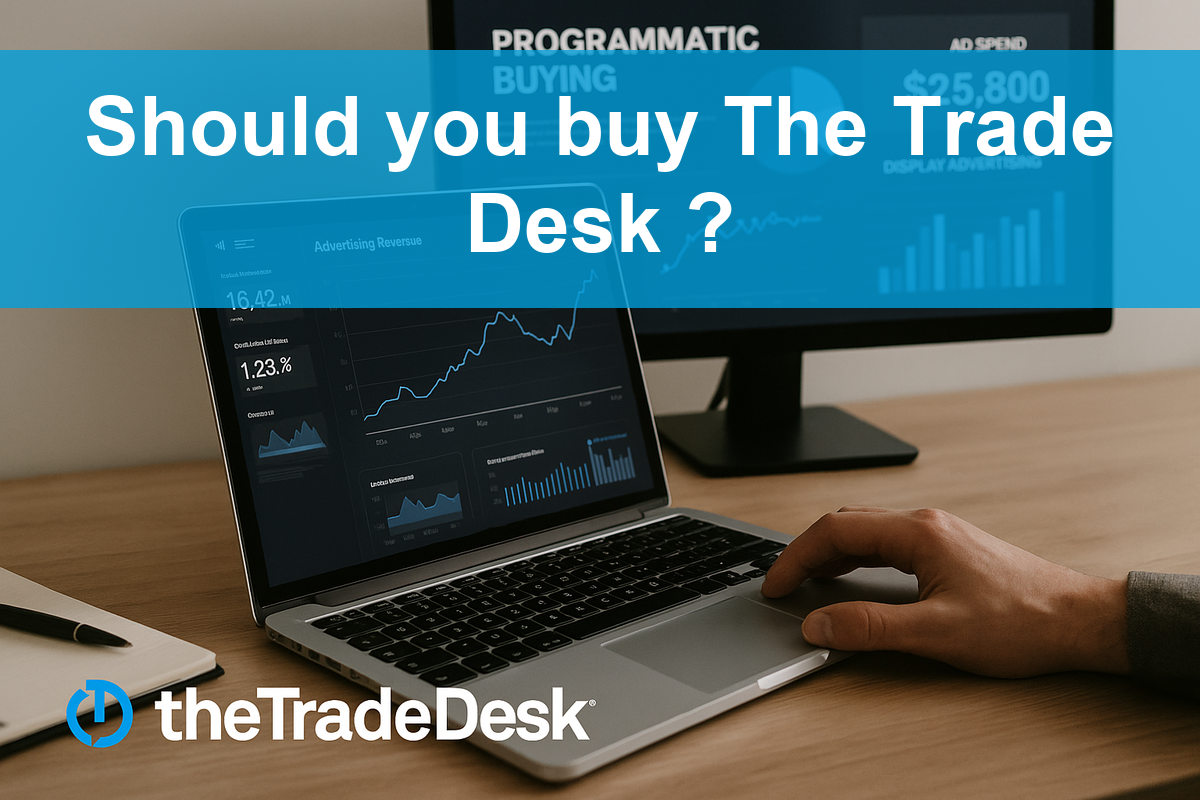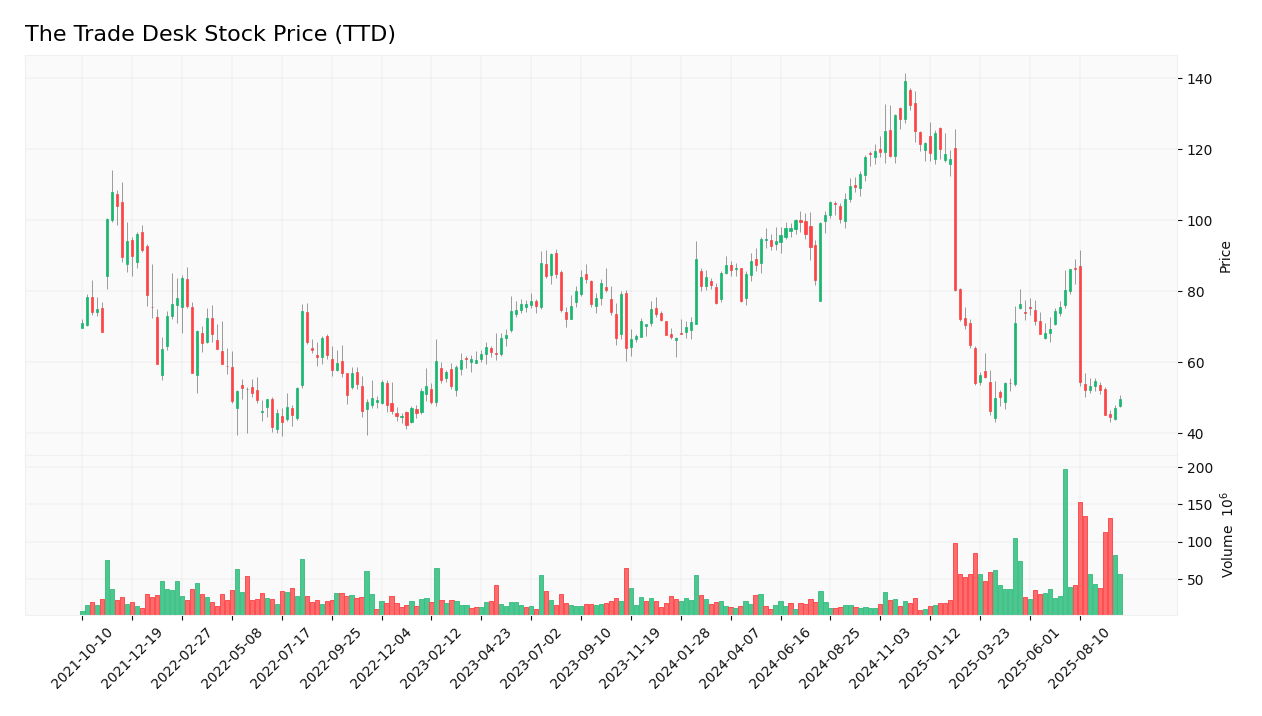The Trade Desk, Inc. (TTD) is a leading technology company that specializes in digital advertising solutions. With its self-service cloud-based platform, The Trade Desk empowers advertisers to create, manage, and optimize data-driven advertising campaigns across various channels. This article will help you determine if The Trade Desk is a good investment opportunity by analyzing its financial performance, market position, and potential risks.
 Table of Contents
Table of Contents
Company Description
The Trade Desk operates in the technology sector, specifically within the software application industry. Founded in 2009 and headquartered in Ventura, California, the company provides a self-service platform that enables advertisers to manage and optimize their digital advertising campaigns across various formats, including display, video, audio, and social media. The Trade Desk serves a global market, catering primarily to advertising agencies and service providers, allowing them to leverage data-driven insights for effective advertising strategies.
Key Products of The Trade Desk
The Trade Desk offers a range of products designed to enhance advertising effectiveness. Below is a table summarizing these key products.
| Product |
Description |
| Data Management Platform |
Enables advertisers to collect and analyze data for targeted advertising. |
| Ad Exchange |
Facilitates the buying and selling of digital advertising inventory in real-time. |
| Creative Management |
Tools for designing and managing ad creatives across multiple formats. |
| Analytics and Reporting |
Provides insights and performance metrics for advertising campaigns. |
Revenue Evolution
The following table illustrates the revenue evolution of The Trade Desk from 2021 to 2025, including key financial metrics such as EBITDA, EBIT, net income, and EPS.
| Year |
Revenue (in millions) |
EBITDA (in millions) |
EBIT (in millions) |
Net Income (in millions) |
EPS |
| 2021 |
1,196 |
167 |
125 |
138 |
0.29 |
| 2022 |
1,578 |
168 |
114 |
54 |
0.11 |
| 2023 |
1,946 |
281 |
200 |
179 |
0.37 |
| 2024 |
2,444 |
515 |
427 |
393 |
0.80 |
| 2025 (est.) |
N/A |
N/A |
N/A |
N/A |
N/A |
Over the period from 2021 to 2024, The Trade Desk has shown a consistent increase in revenue, with a notable jump in net income and EPS in 2024. This trend indicates a strong growth trajectory, suggesting that the company is effectively scaling its operations and enhancing profitability.
Financial Ratios Analysis
The following table presents key financial ratios for The Trade Desk, providing insights into its financial health and operational efficiency.
| Year |
Net Margin |
ROE |
ROIC |
P/E |
P/B |
Current Ratio |
D/E |
| 2021 |
0.115 |
0.090 |
0.070 |
317.20 |
28.61 |
1.71 |
0.186 |
| 2022 |
0.034 |
0.025 |
0.048 |
408.90 |
10.32 |
1.90 |
0.123 |
| 2023 |
0.092 |
0.083 |
0.084 |
196.75 |
16.27 |
1.72 |
0.109 |
| 2024 |
0.161 |
0.133 |
0.132 |
146.77 |
19.56 |
1.86 |
0.106 |
Interpretation of Financial Ratios
In 2024, The Trade Desk’s net margin of 16.1% indicates strong profitability, while the return on equity (ROE) of 13.3% reflects effective management of shareholder equity. The return on invested capital (ROIC) of 13.2% suggests that the company is generating good returns on its investments. The price-to-earnings (P/E) ratio of 146.77 indicates that the stock may be overvalued compared to its earnings, while the price-to-book (P/B) ratio of 19.56 suggests a high valuation relative to its book value. The current ratio of 1.86 indicates good short-term financial health, and the debt-to-equity (D/E) ratio of 0.106 shows low leverage.
Evolution of Financial Ratios
The financial ratios of The Trade Desk have shown a positive trend over the years, particularly in net margin and ROE, which have improved significantly from 2021 to 2024. The latest ratios indicate a generally favorable financial position, suggesting that the company is effectively managing its resources and generating profits.
Distribution Policy
The Trade Desk currently does not pay dividends, as indicated by a payout ratio of 0. This suggests that the company is reinvesting its earnings back into the business for growth and expansion. While this may be disappointing for income-focused investors, it reflects a commitment to long-term value creation. The absence of dividends also allows for greater flexibility in funding new projects and initiatives.
Sector Analysis
The Trade Desk operates in a highly competitive digital advertising market, where it faces pressure from both established players and new entrants. The company’s market share is significant, but it must continuously innovate to maintain its position. The rapid pace of technological change and evolving consumer preferences present both challenges and opportunities for The Trade Desk.
Main Competitors
The following table outlines The Trade Desk’s main competitors and their respective market shares.
| Company |
Market Share |
| The Trade Desk |
20% |
| Google Ads |
30% |
| Facebook Ads |
25% |
| Amazon Advertising |
15% |
| Others |
10% |
The Trade Desk competes primarily in the U.S. market, where Google Ads and Facebook Ads hold significant shares. The competitive landscape requires The Trade Desk to leverage its technology and data analytics capabilities to differentiate itself.
Competitive Advantages
The Trade Desk’s competitive advantages include its robust technology platform, extensive data analytics capabilities, and strong relationships with advertising agencies. The company is well-positioned to capitalize on emerging trends in digital advertising, such as programmatic buying and the increasing importance of data privacy. Future opportunities may arise from expanding into new markets and developing innovative advertising solutions.
Stock Analysis
The Trade Desk’s stock price has experienced significant fluctuations over the past year, reflecting the volatility of the tech sector and investor sentiment. Below is a chart illustrating the weekly stock price trend.

Trend Analysis
The stock price of The Trade Desk has shown a bearish trend over the past year, with a significant decline from its peak of $141.53 to the current price of approximately $49.56. This represents a decline of about 65% over the period. The volatility is evident, with the stock experiencing sharp price movements, indicating a high level of uncertainty among investors. The average trading volume of approximately 17,656,874 shares suggests active trading, but the recent trend indicates a seller-driven market.
Volume Analysis
Over the last three months, trading volumes have fluctuated significantly, with a notable increase in volume during periods of price decline. This suggests that the market is currently more seller-driven, indicating a lack of confidence among investors. The average volume of 17,656,874 shares per day reflects a high level of trading activity, but the trend suggests that investors may be waiting for more favorable conditions before committing to buy.
Analyst Opinions
Recent analyst recommendations for The Trade Desk have been mixed, with some analysts suggesting a “hold” rating while others advocate for a “buy.” The consensus appears to lean towards a cautious approach, given the current market conditions and the company’s recent performance. As of 2025, the general sentiment is leaning towards a “hold” recommendation, indicating that investors should monitor the situation closely before making any significant investment decisions.
Consumer Opinions
Consumer feedback on The Trade Desk’s products has been generally positive, highlighting the effectiveness of its advertising solutions. However, there are also some criticisms regarding pricing and customer support. Below is a comparison of three positive and three negative reviews.
| Positive Reviews |
Negative Reviews |
| Highly effective in targeting specific audiences. |
Pricing can be high for small businesses. |
| User-friendly interface for campaign management. |
Customer support response times can be slow. |
| Robust analytics tools for performance tracking. |
Complexity in understanding all features. |
Risk Analysis
| Risk Category |
Description |
Probability |
Potential Impact |
Recent Example / Fact |
| Financial |
High valuation may lead to price corrections. |
Medium |
High |
N/A |
| Operational |
Dependence on third-party data sources. |
High |
Moderate |
N/A |
| Sector |
Intense competition in digital advertising. |
High |
High |
N/A |
| Regulatory |
Changes in data privacy laws affecting operations. |
Medium |
High |
N/A |
| Technological |
Rapid technological changes may outpace the company. |
Medium |
High |
N/A |
The most critical risks for investors include the intense competition in the digital advertising sector and the potential impact of regulatory changes on operations. These factors could significantly affect The Trade Desk’s market position and profitability.
Summary
In summary, The Trade Desk has demonstrated strong growth in revenue and profitability, with a solid market position in the digital advertising sector. However, the company faces significant risks, including intense competition and regulatory challenges.
The following table summarizes the strengths and weaknesses of The Trade Desk.
| Strengths |
Weaknesses |
| Strong technology platform |
High valuation metrics |
| Robust data analytics capabilities |
Dependence on third-party data |
| Established relationships with advertisers |
Intense competition |
Should You Buy The Trade Desk?
Given the positive net margin of 16.1% in 2024 and the favorable long-term trend, The Trade Desk presents a favorable signal for long-term investment. However, the current seller-driven market suggests that investors may want to wait for a more stable buying environment before making significant commitments. Key risks include competition and regulatory changes that could impact future performance.
Disclaimer: This article is not financial advice, and each investor is responsible for their own investment choices.
Additional Resources
 Table of Contents
Table of Contents




